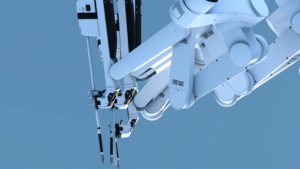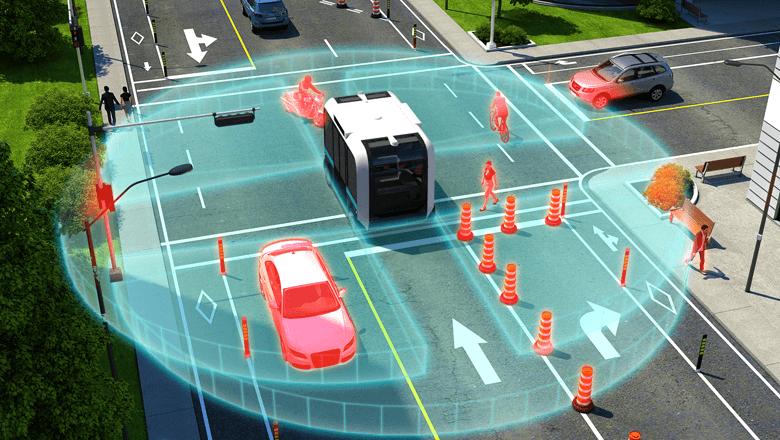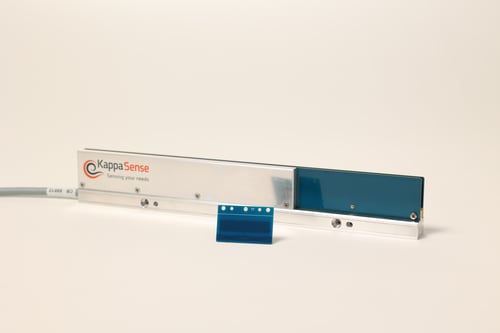Highly accurate position control with the optical encoder

An optical encoder provides contactless measurement of positions, lengths and displacements. They are often used as a feedback loop for the positioning in the control of a machine. This position sensor works on the basis of light and a ruler with a reflection pattern. They position with a low resolution, with an accuracy of up to 1.2 nm! In addition, this technology has low power consumption, making the optical encoder suitable for applications in vacuum environments.
Say you want to do a displacement in a machine. With an encoder, you know where the object is, and what distance it needs to cover to get to the desired position. Does your application require position control with a low resolution and high speeds?
Even in a vacuum environment, the optical encoder can be the solution. Read all about the possibilities of this position sensor.
How does an optical encoder work?
Just like magnetic and inductive encoders, optical encoders work with a ruler. With optical technology, the ruler consists of a pattern of reflectors, or the light-sensitive layer. If an object moves, the encoder is moved across the ruler. These rulers are available in both straight and round versions.
Peter Verstappen, Account Manager at Sentech, explains: “The transmitter of an optical encoder is a light source. Often this is a VCSEL, a piece of silicon that emits light. Once the ruler is illuminated by the sensor, the pattern of reflectors reflects the light back to the receiver. This creates a wave, an amplitude. This movement is converted into a sine and cosine, which are translated into a signal. This signal tells the controller of a motor what the actual position of an object is.”
Feedback loop on positioning
Encoders are often used as a feedback loop for positioning in a machine. What does such a position check look like?
“A motor is given the task of moving an object from A to B. To know where the object is in the movement between A and B, you need a measurement. This measurement is the feedback loop to the motor controller. If the motor controller knows where the object is, the motor can deliver the right amount of power to bring the object to the desired position,” says Verstappen.
Incremental or absolute
Optical encoders are available as incremental and absolute systems. What is the difference between these two types of encoders?
Incremental encoders
An incremental encoder measures step by step. This is because they measure the change and direction of motion. At startup, an incremental system must ‘home’ to find the index – or zero position.
Absolute encoders
An absolute encoder immediately gives the actual position. This encoder type does not need to ‘home’. The system sees every position as a unique signal.
Relative to incremental encoders, absolute encoders are more complex and have a higher latency value, causing a delay in data transmission.

If component size plays a major role, precise placement is very important. Placement speed is also crucial here. This enables you to offer end products at competitive prices.
Five advantages of an optical encoder
-
Very accurate
With a resolution of up to 1.2 nm, optical encoders are some of the most accurate measurement systems in the field of positioning.
-
Compact design
Due to its compact design, the optical encoder is easy to integrate into machines with a small footprint. For example, enclosures are available at 9 x 7 x 1.2 mm.
-
High speeds
Thanks to their advanced technology, optical encoders are suitable for high-speed applications. From 3 meters per second for entry-level systems and 10 meters per second for advanced systems.
-
Suitable in vacuum
Because the light source of the optical encoder is a VCSEL, they require less power so they get much less hot. This also makes this technology suitable for vacuum environments.
-
Insensitive to electronic interference
They are insensitive to external electronic interference. This is because optical systems work with a balanced A and B signal. If this signal is disrupted, the differences between the A and B signals remain. This leaves a good signal.
When do you use an encoder?
Before you select a specific type of encoder, it is important to know what an encoder does. An encoder is used to measure positions, lengths and displacements. They are often used to check a position, i.e. as a feedback loop for the positioning in motor or machine control.
Depending on the requirements and environmental factors, determine which type of encoder best fits your application. For instance, an inductive encoder or magnetic encoder is more suitable for a contaminated environment.

Optical encoders by Celera Motion with MicroE technology are made of materials suitable for vacuum environments.
Position control in vacuum
There are no air molecules in vacuum environments. Without air molecules, electronic systems struggle or are unable to release their heat. “For optical encoders with a lens, this means that they get too hot, causing them to break down quickly. Because the MicroE encoders contain a VCSEL, they consume less power and become much less hot. That makes this encoder suitable for vacuum environments,” Verstappen explains.
Do you want to use a system that gets too hot for a vacuum space? Then connect the system with conductive material. This is the only way to release heat in a vacuum.
Highly accurate displacement measurement
An optical encoder measures displacement with an accuracy of up to 1.2 nm. However, the actual accuracy is determined by several factors, which also affects the price of the system. Therefore, it is important to know what degree of accuracy your application really needs.
Absolute and repeat accuracy
Encoder systems are made up of two factors that determine the precision of your measurement. These are absolute accuracy and repeat accuracy. When selecting a position sensor, it is good to know the extent to which these factors are important to your application.
Absolute accuracy is the actual position in the space, without pre-calibration or generating a reference signal. With repeat accuracy, an index signal is present. When the machine starts, the encoder always goes to this preset point first. This point is always the same. All movements then take place from the index.
Explanation
With absolute accuracy, you move 10.000 mm, but how accurate is this 10.000 mm in reality? That 10.000 mm could actually be 10.004 mm. Repeat accuracy is when you send the machine to the same position ten times. The repeat accuracy is the deviation from this position.
Tolerance field
Both absolute accuracy and repeat accuracy have degrees of precision. The smaller the tolerance field, the more accurate the measurement. Suppose the absolute accuracy is 10 μm and the repeat accuracy is 1 μm. Then the encoder may deviate from the reference point by a maximum of 1 μm. This margin may deviate 10 μm from the actual (absolute) position.
The degree of absolute accuracy has a major influence on the price of an encoder system. When mainly repeat accuracy is important, you usually end up with a more affordable system. A high repeat accuracy is often sufficient for a reliable measurement.
Ruler material
Each material has its own expansion coefficient. For instance, a metal ruler expands at high temperatures and temperature changes. Glass, on the contrary, has no expansion coefficient, which means a glass ruler is more reliable at higher temperatures.

Interpolation: an even lower resolution
Do you want a lower resolution? That, too, is possible! By interpolating the signal, you can measure more steps per second. The original signal is divided into even smaller steps. How much you can interpolate depends on the capacity of your control: the input frequency must be able to process the pulse train. Make sure the input frequency of the control is higher than the output frequency of the encoder.
How to prevent a contaminated encoder
Because optical systems work with light, dust and dirt are disastrous for the measurement results. To limit contamination, you can take this into account with the integration of the encoder.
The Account Manager explains: “In the design, there are features that make the system less likely to become dirty. For instance, you can mount it upside down or place it under a cover. Also think of fingerprints. In certain positions, the ruler will more easily come into contact with the fingers. Moreover, optical systems can be cleaned. It is recommended to account for this in the design as well.”
How to select the right optical encoder
There are many different types of optical systems. To select the right optical encoder, it is important to know the requirements and environmental factors of your application. It is important to be specific here.
For example, if you know that low resolution is important for your application, you also want to know exactly how accurate your system needs to be. And whether the control of your system can handle it.
Identify what specifications you really need for your application together with our sensor expert.




